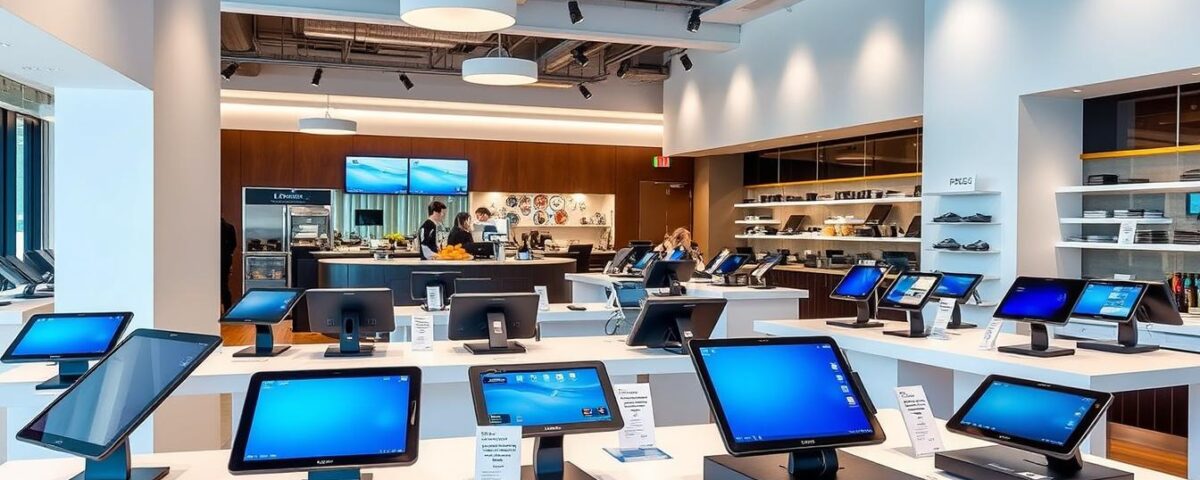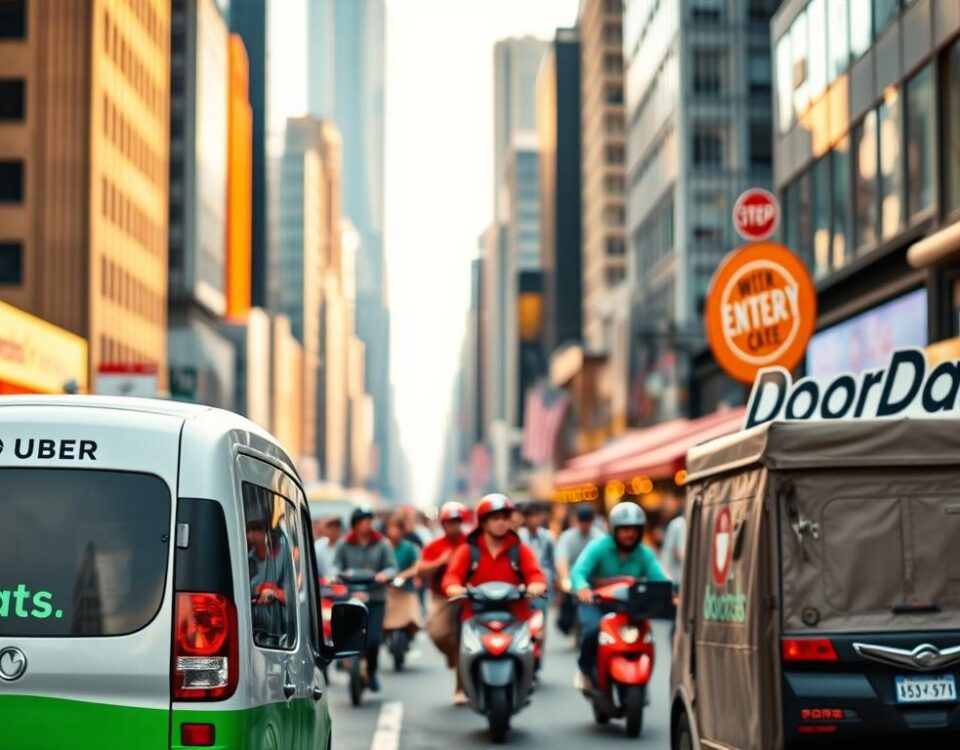
Should You Add Kiosks? How They Boost Orders Without Hiring
August 24, 2025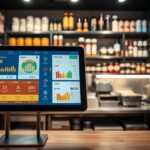
I Compared 5 Inventory Tools—Here’s the Best One for Restaurants
August 25, 2025As a restaurant owner, you understand the importance of a seamless dining experience. But have you ever stopped to think about the engine that keeps your operations running smoothly? A point of sale (POS) system is more than just a tool for processing payments; it’s the backbone of your business.
Did you know that a well-chosen POS system can increase efficiency, reduce costs, and enhance customer satisfaction? With the restaurant industry evolving rapidly, modern POS systems now offer advanced features beyond payment processing, such as inventory management and sales analytics. As we navigate the complex world of restaurant POS systems in 2025, I’ll guide you through the top solutions, comparing their features, pricing, and overall value to help you make an informed decision.
Choosing the right POS system can be a game-changer for your restaurant. So, what are the key factors to consider when selecting a POS system that aligns with your business goals and budget?
Key Takeaways
- Understand the essential features to look for in a POS system for your restaurant.
- Compare the top POS systems available in 2025, including their pricing structures.
- Discover how modern POS systems can enhance your restaurant operations beyond payment processing.
- Learn how to choose a POS system that aligns with your business goals and budget.
- Get insights into the latest trends and advancements in POS technology.
Understanding Restaurant POS Systems in 2025
As we dive into 2025, the landscape of restaurant POS systems is more complex and integrated than ever. A POS system works with various tools to help you keep track of inventory, record sales, and learn what customers like, ultimately saving you time to focus on creating great dining experiences.
What Makes a Modern Restaurant POS System
Modern restaurant POS systems in 2025 have evolved far beyond simple cash registers. They now function as comprehensive business management platforms that integrate all aspects of restaurant operations. The core of what makes a modern restaurant POS system valuable is its ability to seamlessly connect front-of-house and back-of-house operations while providing real-time data and analytics.
Key features of these systems include cloud-based technology, which has revolutionized POS systems by allowing restaurant owners to access their business information from anywhere and enabling automatic software updates without disruption.
- Cloud-based technology for remote access and automatic updates
- Integration of front-of-house and back-of-house operations
- Real-time data and analytics for informed decision-making
Key Advancements in POS Technology for 2025
In 2025, POS technology has seen significant advancements, including AI-powered inventory management, predictive analytics for sales forecasting, and enhanced integration capabilities with third-party delivery platforms. The best modern POS systems now offer contactless payment options, tableside ordering capabilities, and sophisticated customer relationship management tools that help restaurants build loyalty.
Additionally, mobile compatibility has become standard, with most systems offering dedicated apps that allow managers to monitor performance metrics and make adjustments even when they’re away from the restaurant. Advanced security features have also become essential components of modern POS systems, protecting both customer payment data and sensitive business information from potential breaches.
“The future of restaurant POS systems lies in their ability to integrate technology with customer service, creating a seamless experience that drives loyalty and growth.”
Essential Features to Look for in Restaurant POS Systems
When selecting a restaurant POS system, it’s crucial to identify the features that will enhance your operations. A modern POS system is more than just a tool for processing transactions; it’s a comprehensive solution that can streamline your restaurant’s workflow, improve customer satisfaction, and increase profitability.
Core Operational Features
Core operational features are the backbone of any effective POS system. These include order management, which streamlines the process of taking, tracking, and fulfilling orders in real-time. A good POS system should also offer menu management capabilities, enabling staff to directly create, adjust, and customize the menu to ensure items, prices, and descriptions are current and accurate.
Another critical feature is table management, which provides a visual layout of the restaurant to manage seating arrangements and maximize space utilization. Additionally, a kitchen display system (KDS) sends orders directly to kitchen displays, reducing errors and speeding up food preparation.
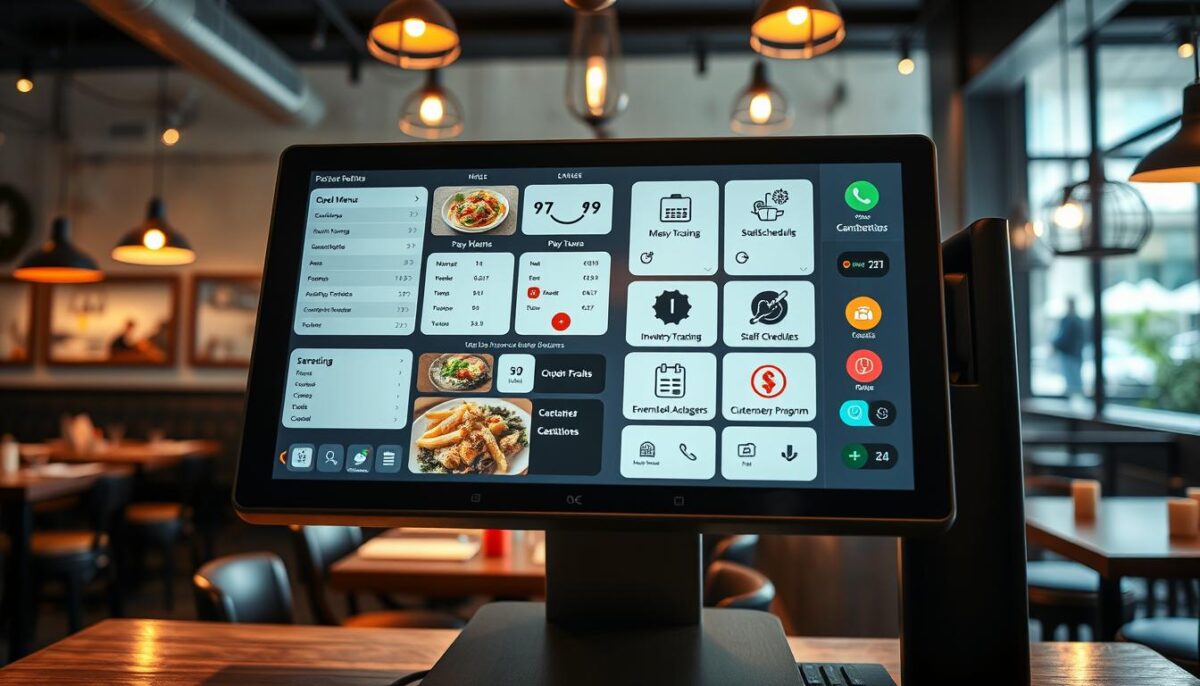
Advanced Management Capabilities
Beyond core operational features, advanced management capabilities can significantly enhance your restaurant’s efficiency. Inventory management is a crucial aspect, as it tracks ingredient usage in real-time, automatically updates stock levels when orders are placed, and alerts managers when supplies run low.
Other advanced features worth considering include detailed reporting and analytics, which provide insights into sales patterns, labor costs, and menu performance. These insights can help optimize your restaurant operations and improve profitability. Employee management tools are also essential, allowing for time tracking, performance monitoring, and simplified scheduling, which can significantly reduce administrative workload.
Furthermore, customer relationship management features have become increasingly important. The best POS systems offer tools to collect customer data, track preferences, and implement loyalty programs that drive repeat business. Integration capabilities are also vital, as your POS system needs to work seamlessly with accounting software, online ordering platforms, and other business tools you may already be using.
Lastly, mobile accessibility has evolved from a nice-to-have to a must-have feature. It allows managers to monitor performance, make menu adjustments, and view reports from anywhere using smartphones or tablets, providing flexibility and enhancing decision-making.
How Restaurant POS Systems Impact Your Bottom Line
A restaurant POS system is more than just a tool for processing transactions; it’s a key to unlocking your business’s full potential. By streamlining operations, reducing labor costs, and minimizing inventory waste, the right POS system can significantly impact your bottom line.
Cost Considerations and ROI
When evaluating a POS system, it’s essential to consider both the direct cost savings and the revenue-generating benefits. Direct cost savings can come from reduced food waste, lower labor costs, and minimized inventory waste through precise tracking and management.
On the other hand, revenue-generating benefits can be achieved through faster table turnover, increased average check size, and improved customer satisfaction. By automating routine tasks and providing real-time data, modern POS systems can dramatically improve operational efficiency.
- Streamline operations and reduce labor costs
- Minimize inventory waste through precise tracking and management
- Improve customer satisfaction through faster service and reduced order errors
Efficiency and Revenue Benefits
The reporting capabilities of advanced POS systems allow restaurant owners to identify their most profitable menu items, busiest service periods, and highest-performing staff members. This information can be leveraged to increase revenue and improve overall efficiency.
| Feature | Benefit | Impact on Bottom Line |
|---|---|---|
| Automated Inventory Management | Reduced waste and lower inventory costs | Increased profitability |
| Real-time Sales Reporting | Faster decision-making and improved sales strategies | Increased revenue |
| Staff Performance Tracking | Improved staff performance and reduced labor costs | Increased efficiency and profitability |
By reducing order errors and improving kitchen communication, a good POS system can enhance the customer experience, leading to higher satisfaction, better reviews, and increased repeat business. The initial investment in a quality POS system may seem substantial, but the long-term benefits typically outweigh the costs.
Restaurant POS Systems Comparison 2025: Top Contenders
In 2025, the competition among restaurant POS systems is fierce, with top contenders vying for the attention of restaurant owners. To help you make an informed decision, I’ve evaluated these systems based on comprehensive criteria.
Evaluation Criteria
My evaluation places special emphasis on features that matter most to restaurant operators, including inventory management capabilities, staff management tools, reporting depth, and integration flexibility. These features are crucial for streamlining operations and improving customer satisfaction.
- Core functionality and ease of use
- Pricing structure and total cost of ownership
- Hardware requirements and compatibility
- Customer support quality and responsiveness
Comparison Methodology
To ensure a fair and accurate comparison, I’ve tested each system’s performance in real-world restaurant scenarios and gathered feedback from actual users. This approach provides a comprehensive view of how each POS system performs in different environments.
The comparison includes both established industry leaders and innovative newcomers to the restaurant POS market, providing a comprehensive view of all viable options available in 2025. Each system has been rated on its ability to scale with your business, adapt to changing industry trends, and provide ongoing value through regular updates and new feature additions.
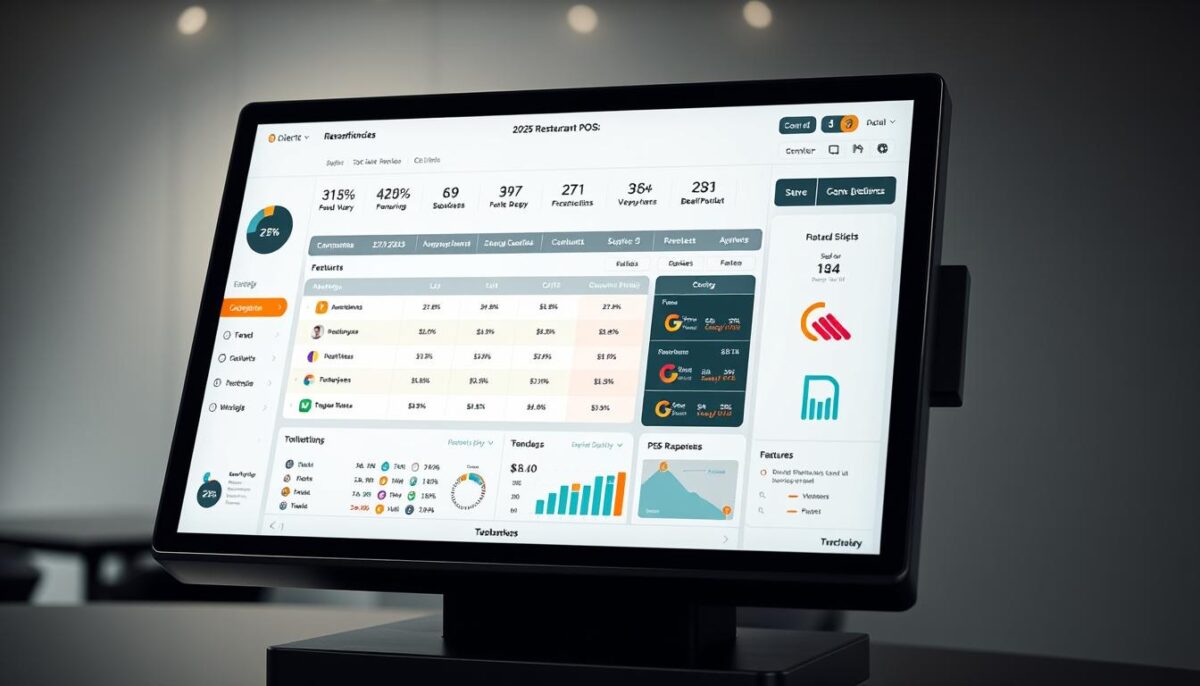
| POS System | Website | Mobile App | Loyalty Program | Automated Marketing | Customer Data |
|---|---|---|---|---|---|
| Square | ✔️ | ✔️* | ✔️ | ✔️ | ✔️ |
| SpotOn | ✔️ | ✔️ | ✔️ | ✔️ | ✔️ |
| Toast POS | ✔️ | ✔️ | ✔️ | ✔️ | ✔️ |
| TouchBistro | ❌ | ✔️ | ✔️ | ✔️ | ✔️ |
| Clover | ✔️ | ✔️ | ✔️ | ✔️ | ✔️ |
* Mobile ordering page with homepage access—not a full, independent app. Add-on features that are priced separately or bundled.
Square for Restaurants: Best for Small and Growing Establishments
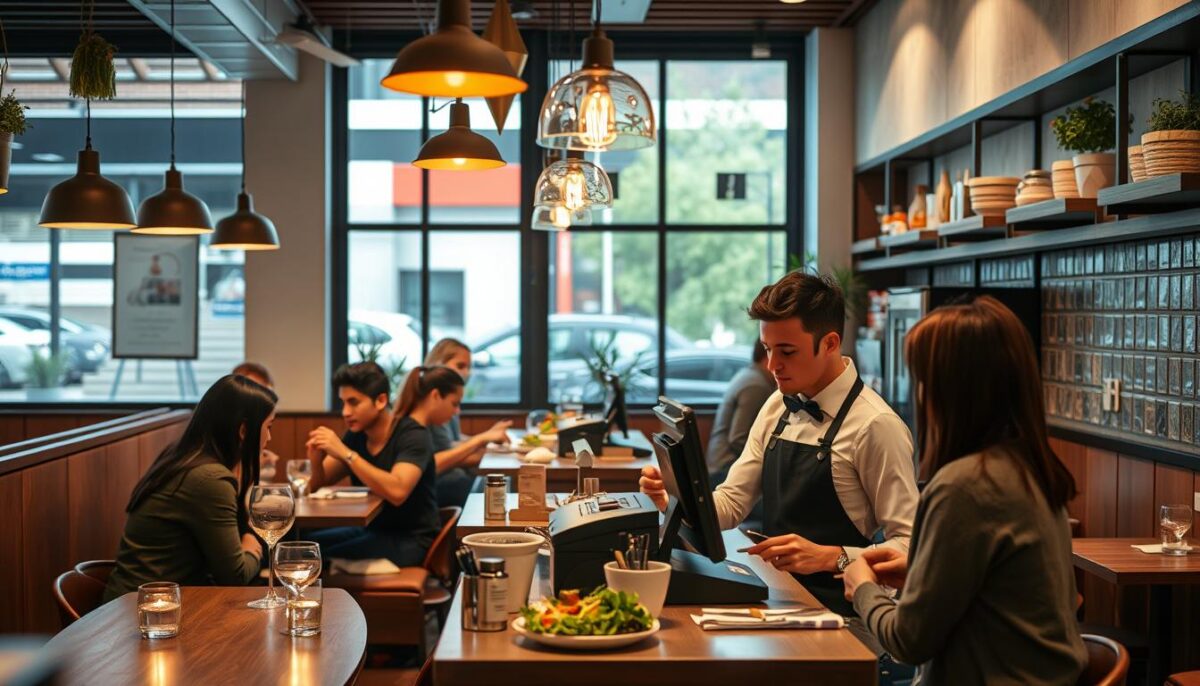
Square for Restaurants is my top recommendation for small and growing establishments in 2025, offering an impressive balance of functionality and affordability with its free starter plan that includes essential POS features.
Overview
Square for Restaurants is designed to cater to the needs of small and growing establishments, providing a comprehensive POS system that is both user-friendly and feature-rich. The system’s intuitive interface makes it easy for staff to navigate, reducing training time and improving overall efficiency.
Key Features
The key features of Square for Restaurants include flexible table management, menu customization options, and a free online ordering page that comes standard with all plans. This makes it exceptionally valuable for restaurants looking to expand their takeout business. Additionally, the system’s compatibility with both iOS and Android devices gives restaurant owners flexibility in their hardware choices.
Key Features:
- Flexible table management
- Menu customization options
- Free online ordering page
- Compatibility with iOS and Android devices
Pricing Structure
The pricing structure of Square for Restaurants is transparent and scalable, starting with a free plan for basic needs and stepping up to the Plus plan at $69/month and Premium plan at $165/month as your restaurant grows and requires more advanced features.
Pricing Plans:
- Free Plan: $0/month
- Plus Plan: $69/month
- Premium Plan: $165/month
Pros and Cons
One of the main advantages of Square for Restaurants is its lack of long-term contracts or installation fees, making it a low-risk option for new restaurants. However, the free plan doesn’t include 24/7 support, and there are fewer advanced inventory management features compared to some competitors.
Pros:
- No long-term contracts or installation fees
- Free online ordering page with all plans
- Compatible with both iOS and Android devices
Cons:
- Limited 24/7 support on the free plan
- Fewer advanced inventory management features
SpotOn Restaurant: Best Variety of Add-On Features

In the competitive world of restaurant POS systems, SpotOn Restaurant distinguishes itself with a wide array of add-on features, making it an attractive option for restaurants seeking a tailored solution.
Overview of SpotOn Restaurant POS System
SpotOn Restaurant is designed to offer flexibility and customization, allowing restaurant owners to build a POS system that matches their specific operational needs. The system’s adaptability is one of its strongest selling points, catering to a variety of restaurant types and sizes.
Key Features of SpotOn Restaurant
The SpotOn Restaurant POS system boasts an impressive range of features, including:
- Robust reservation management
- Comprehensive loyalty programs
- Integrated online ordering capabilities
- Advanced employee scheduling tools
These features can be added or removed as needed, allowing restaurants to customize their POS system according to their specific requirements.
Pricing Structure
SpotOn Restaurant offers a tiered pricing structure to accommodate different types of restaurants:
- Quick Start plan: Free, with a processing fee of 2.89% + $0.25 per transaction
- Counter-service plan: $99/month + $3 per employee, with a processing fee of 1.99% + $0.25 per transaction
- Full-service plan: $135/month + $3 per employee, with a processing fee of 1.99% + $0.25 per transaction
Hardware costs vary, with the Kitchen Display System (KDS) starting at $600 and the Counter POS at $850.
Pros and Cons
The SpotOn Restaurant POS system has several advantages, including its customizable plans, competitive payment processing rates, and 24/7 phone support. However, it also has some drawbacks, such as setup fees and the additional cost of a router for offline mode functionality.
Overall, SpotOn Restaurant is a versatile and feature-rich POS solution that can be tailored to meet the unique needs of various restaurants, making it a compelling choice in the 2025 POS landscape.
Toast POS: Best for Restaurants Doing Dine-In and Online Business
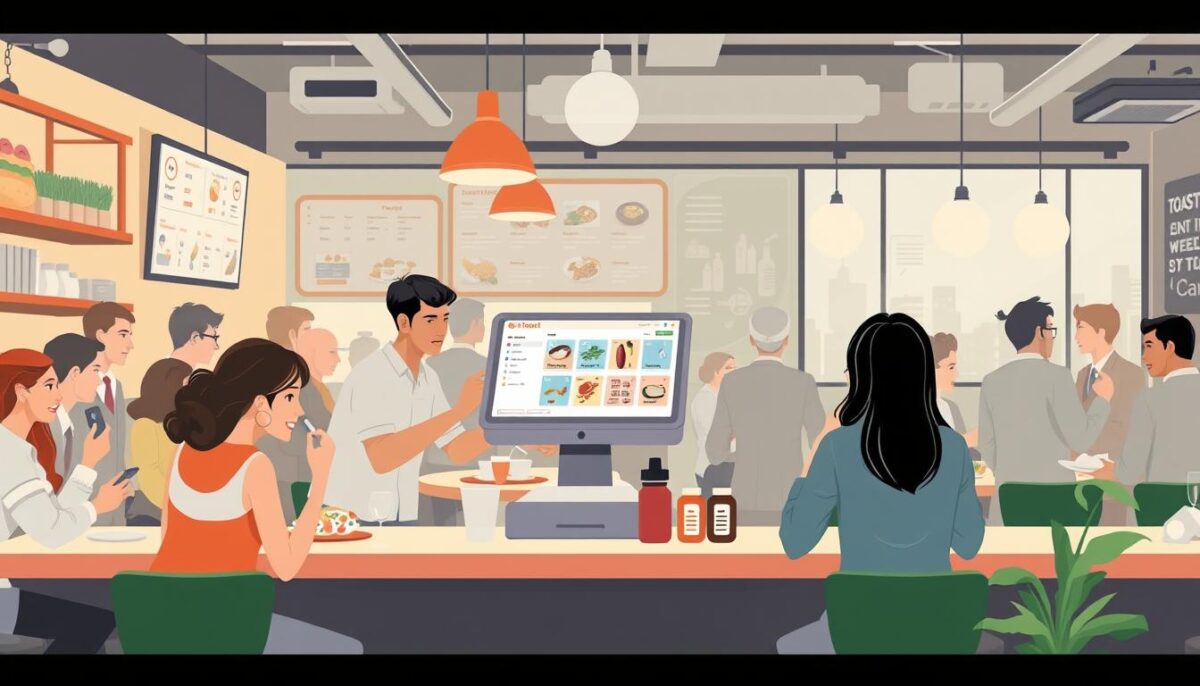
In the competitive landscape of restaurant POS systems, Toast POS stands out for its comprehensive features that cater specifically to restaurants balancing dine-in and online business models. Toast POS has established itself as a premier solution, offering integrated delivery and takeout capabilities that create a seamless experience across all service channels.
Overview
Toast POS was built specifically for restaurants from the ground up, evident in its industry-specific features like in-house delivery management, kitchen display integration, and menu modification tracking. These features are often lacking in generic POS systems, making Toast a preferred choice for restaurants with complex operations.
Key Features
The system offers a range of key features that enhance restaurant operations. These include:
- Integrated Delivery Management: Toast POS allows for efficient management of in-house delivery, making it easier to handle orders and customer requests.
- Kitchen Display Integration: The system integrates well with kitchen displays, ensuring that orders are prepared efficiently and reducing wait times.
- Menu Modification Tracking: Toast POS enables detailed tracking of menu modifications, helping restaurants to manage their offerings effectively.
- Online Ordering Integration: While online ordering is considered an add-on, Toast POS facilitates a smooth experience for customers ordering online.
Pricing Structure
Toast POS offers a flexible pricing structure to accommodate different restaurant needs. The software pricing starts with a free Starter Kit plan for restaurants with up to two terminals, moving up to the $69/month Point of Sale plan for additional features. Custom enterprise plans are available for larger operations.
The hardware costs vary, with options like the Handheld Starter Kit ($494.10), Countertop Starter Kit ($1,123.20), and Guest Self-Service Starter Kit ($1,438.20). Toast also offers a “Pay-as-you-Go” pricing option that eliminates upfront hardware costs in exchange for slightly higher processing fees.
Pros and Cons
Toast POS has several advantages, including its industry-specific features, 24/7 support via web messaging, and helpful related services like payroll and team management software. However, it also has some drawbacks, such as the requirement for a two-year contract with early termination fees, higher online payment processing rates compared to some competitors, and additional costs for setup and offline mode.
When considering Toast POS, it’s essential to weigh these pros and cons in the context of your restaurant’s specific needs and operations.
TouchBistro: Best for Front-of-House Operations
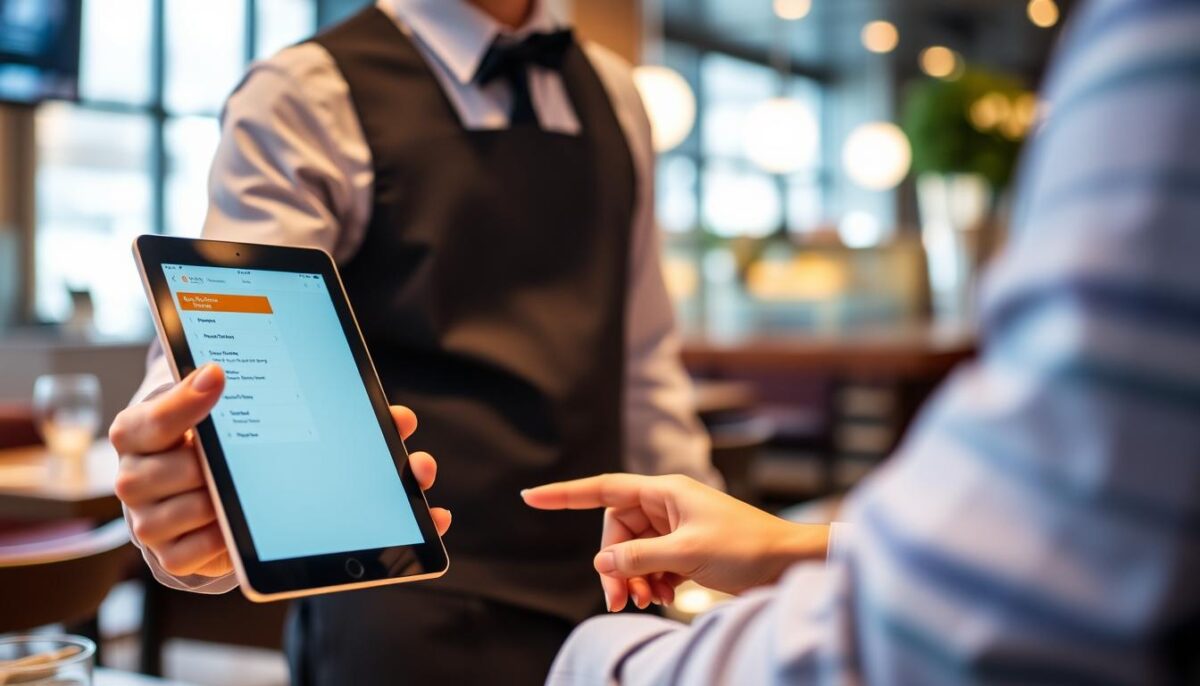
TouchBistro’s POS system stands out for its ability to enhance front-of-house operations, making it a top choice for restaurants. With its comprehensive features and user-friendly interface, TouchBistro is designed to streamline restaurant management.
Overview
TouchBistro is a hybrid POS system that offers exceptional table management features, displaying total spend and time seated per table. This allows servers to provide better customer service and manage tables more efficiently. The system’s offline functionality ensures that restaurants can continue to operate even during internet outages, accepting payments, taking orders, editing menus, and managing staff.
Key Features
Some of TouchBistro’s key features include:
- Advanced Table Management: TouchBistro’s table management features are designed to help servers manage tables effectively, improving customer satisfaction and increasing table turnover.
- Profit Management Tools: The system’s profit management tools offer advanced inventory tracking, vendor management capabilities, and detailed reporting to help restaurant owners identify opportunities to increase margins.
- Offline Functionality: As a hybrid POS system, TouchBistro can operate without the cloud, ensuring that restaurants can continue to function during internet outages.
- Comprehensive Support: TouchBistro offers 24/7 phone, chat, and email support, providing valuable assistance to restaurants operating late hours or experiencing technical issues during peak service times.
Pricing Structure
TouchBistro’s pricing starts at $69 per month for the base plan. Additional features such as gift cards, online ordering, loyalty programs, and reservations are available at quote-based prices, which can significantly increase the total cost. The payment processing fees are also quote-based if you use TouchBistro Payments, but you can choose from third-party payment processors.
Pros and Cons
TouchBistro’s pros include its comprehensive features, user-friendly interface, and robust support. However, some drawbacks include quote-based payment processing rates, contracts that automatically renew and can’t be terminated early, setup fees, and extra charges for online ordering capabilities.
In conclusion, TouchBistro is an excellent choice for restaurants focused on optimizing their front-of-house operations. Its advanced features, offline functionality, and comprehensive support make it a valuable tool for restaurant management.
Clover Restaurant: Best for Quick-Service Restaurants
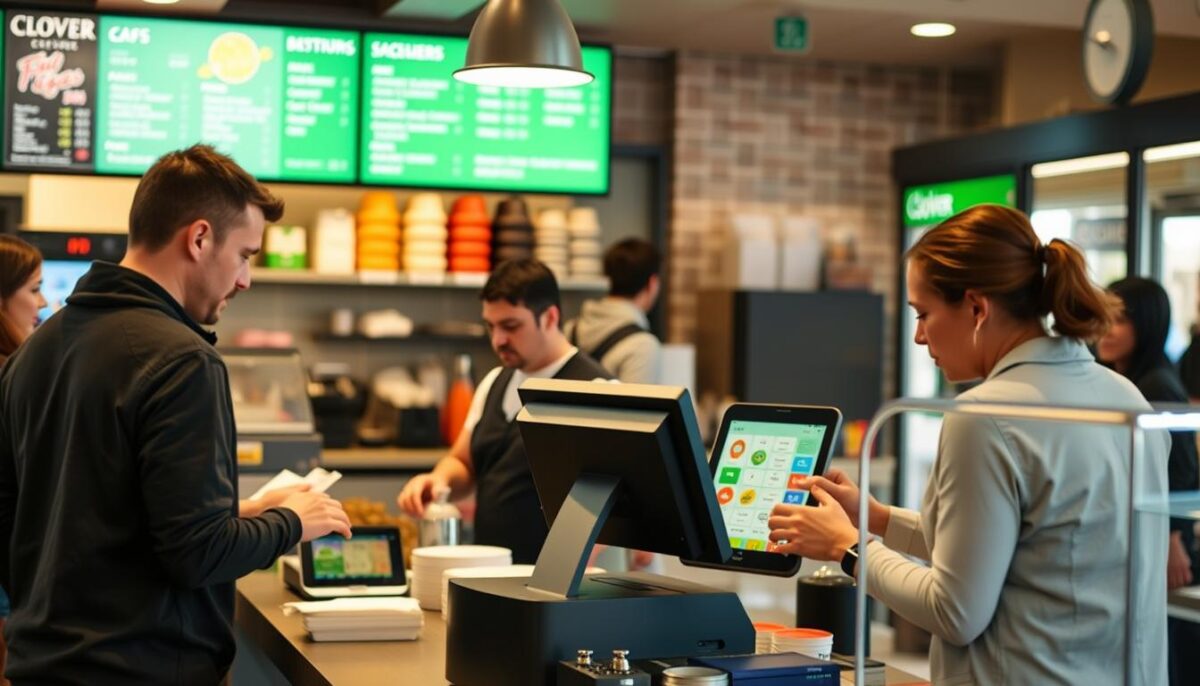
In the competitive quick-service restaurant landscape, Clover POS stands out as a top choice. Its comprehensive features and robust hardware make it an ideal solution for restaurants looking to streamline their operations.
Overview
Clover Restaurant POS system is designed to cater to the unique needs of quick-service restaurants. With its advanced features and hardware options, it provides a fully integrated experience from order entry to food preparation.
Key Features
The Clover POS system offers several key features that make it suitable for quick-service restaurants. These include:
- Mobile POS terminals like the Clover Flex ($749) that enable staff to take orders and process payments on the go, perfect for managing long lines efficiently.
- Offline functionality that allows restaurants to continue accepting payments even when internet connectivity is disrupted.
- Online ordering capabilities as standard features in Full-Service and Quick-Service Restaurant plans, giving restaurants an advantage in the takeout and delivery market segments.
- Extensive hardware options, including the $199 Clover Go card reader, $1,899 Clover Station Duo, and $3,499 self-ordering kiosk.
- Kitchen display hardware and software (priced at $799-$899 plus $25 monthly) that creates a fully integrated experience from order entry to food preparation.
Pricing Structure
Clover’s pricing structure is tiered based on business type and service level. For Quick-Service Dining plans, the pricing starts at $89.95 per month for the Starter plan and ranges up to $109.90 for the Advanced plan.
The payment processing rates are competitive for restaurant-specific plans at 2.3% plus 10 cents for in-person transactions. However, online and keyed-in transactions are higher at 3.5% plus 10 cents.
Pros and Cons
The Clover POS system has several pros and cons that are worth considering:
- Pros:
- 24/7 customer support.
- Includes online ordering capabilities.
- Hardware and software features designed for various dining services.
- Cons:
- Must use Clover’s proprietary hardware.
- Monthly software fee and hardware costs may be prohibitively high for some businesses.
Lightspeed Restaurant: Best for Established Multi-Location Restaurants
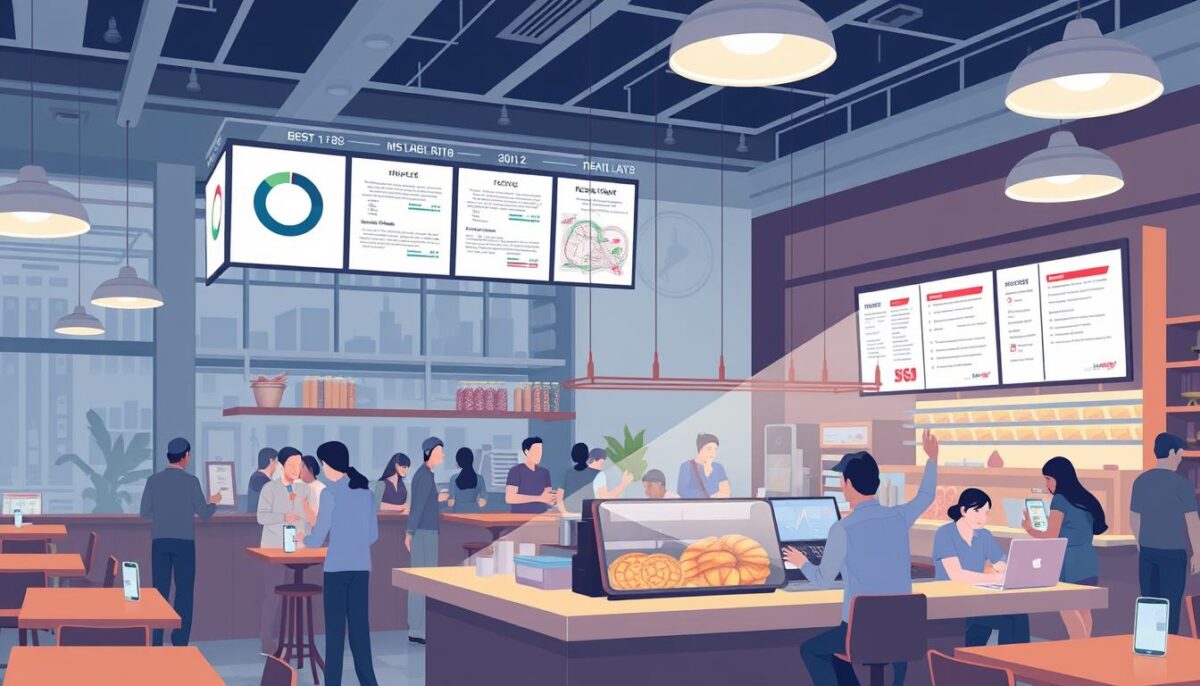
Lightspeed Restaurant POS stands out as a premier solution for established multi-location restaurants in 2025, offering powerful multi-site management tools that allow owners to standardize operations while still accommodating location-specific needs.
Overview of Lightspeed Restaurant POS
Lightspeed Restaurant is designed for established restaurants with multiple locations, providing advanced features that simplify management across different sites. The system’s advanced inventory management and recipe costing capabilities give restaurant groups precise control over food costs, helping identify opportunities to improve margins.
Key Features of Lightspeed Restaurant POS
The POS system includes several key features that make it ideal for multi-location restaurants:
- Multi-site management: Allows for standardized operations across locations.
- Advanced inventory management: Provides precise control over food costs and helps in identifying areas for improvement.
- Customer Relationship Management (CRM) and loyalty programs: Included in all plans, these features help build stronger customer relationships.
- Robust reporting capabilities: Enables owners to compare performance across sites and address underperforming locations.
Pricing Structure
Lightspeed’s pricing reflects its focus on established businesses, with plans starting at $189 for the Essential tier and $399 for the Premium tier. While this is significantly higher than entry-level competitors, the comprehensive feature set justifies the cost.
The hardware requirements are flexible within the Apple ecosystem, with compatibility for various iPad models. However, Android tablets are not supported, which is an important consideration for restaurants with existing hardware.
Pros and Cons
Pros:
- Offers advanced inventory management and recipe costing tools.
- All plans include CRM and loyalty programs.
- Essential and Premium plans include one-on-one support, with 24/7 support available.
Cons:
- Syncing with accounting software costs extra.
- Some plans may require long-term contracts.
- The lowest-tier plan is more expensive than competitors.
In conclusion, Lightspeed Restaurant POS is tailored to meet the needs of established multi-location restaurants, offering a robust set of features that simplify management and improve customer relationships. While the pricing may be higher than some competitors, the benefits provided make it a valuable investment for the right businesses.
Additional Contenders Worth Considering
While major brands dominate the market, niche POS systems like Lavu and SumUp offer compelling alternatives for certain restaurant needs.
Lavu: Best for Cash Discount Programs
Lavu stands out for its cash discount program capabilities, allowing restaurants to offer different pricing for cash versus card payments—potentially saving thousands in processing fees annually for high-volume establishments.
Starting at just $9.99 per month, Lavu offers an affordable entry point with features like team management, inventory tracking, and Bluetooth scale integration included in all plans.
Key Features: Highly customizable POS platform, 24/7 support, dual pricing program.
Pros and Cons: While Lavu doesn’t offer free plans and locks you into your subscription term, its benefits make it a valuable choice for restaurants with specific needs.
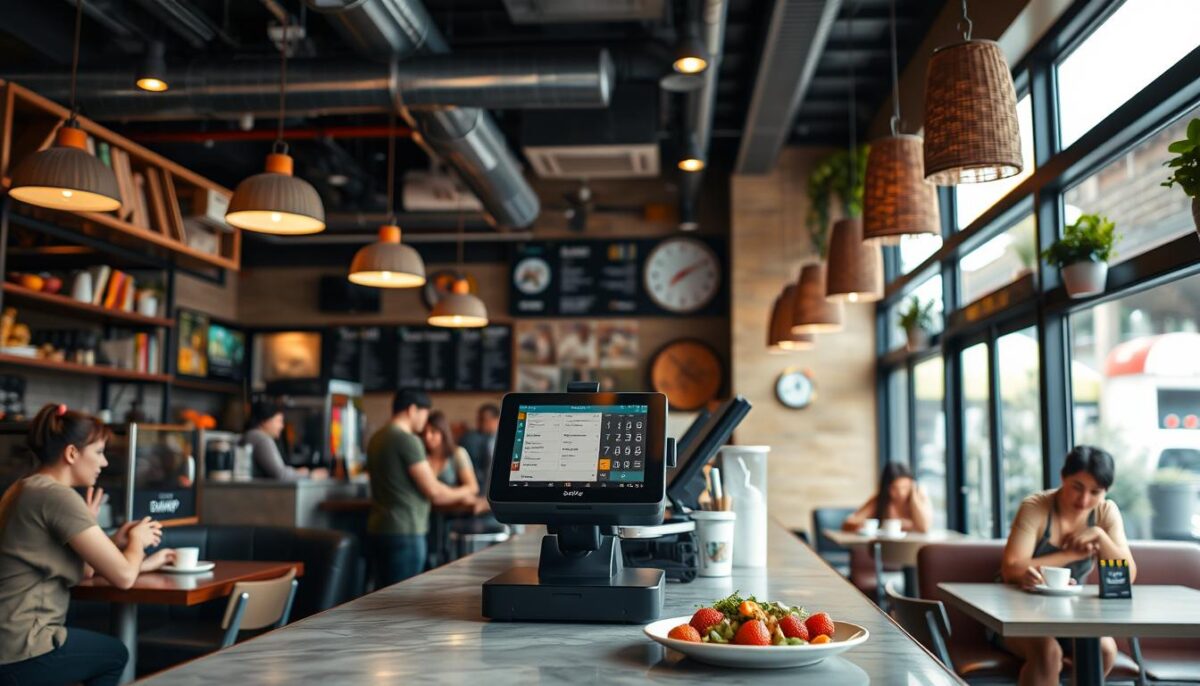
SumUp: Best for Building Customer Base
SumUp has carved out a niche as the best system for building a customer base, with AI-powered marketing tools that can send targeted promotions to customers via text and email—a standout feature for new restaurants looking to establish loyalty.
With plans ranging from a free POS Lite option to the comprehensive Connect Pro plan at $289 monthly, SumUp offers scalable solutions that can grow with your restaurant’s marketing sophistication.
Key Features: Automated marketing tools, affordable hardware options, available in more than 30 countries.
Pros and Cons: While SumUp charges higher rates for online transactions and requires a 12-month commitment for its money-back guarantee, its benefits make it an attractive option for restaurants looking to build their customer base.
How to Choose the Right Restaurant POS System for Your Business
In the ever-evolving landscape of restaurant technology, selecting a POS system that aligns with your business goals is crucial for success. As a seasoned expert, I’ve worked with various restaurants to help them find the perfect POS system that meets their unique needs.
Assessing Your Restaurant’s Specific Needs
When choosing a restaurant POS system in 2025, it’s essential to start by clearly defining your specific operational needs. Consider factors like restaurant type (quick-service, full-service, etc.), service model, menu complexity, and growth plans. For instance, a restaurant with complex recipes may require a POS system with robust inventory management features.
- Evaluate how each POS system handles your most critical operational challenges, whether that’s inventory management for a restaurant with complex recipes or online ordering integration for a business with significant takeout volume.
- Consider your staff’s technical proficiency and the system’s ease of use—even the most feature-rich POS will fail if your team struggles to operate it efficiently during busy service periods.
- Request detailed information about the total cost of ownership, including monthly software fees, hardware costs, payment processing rates, and charges for additional features or users that you might need as your business grows.
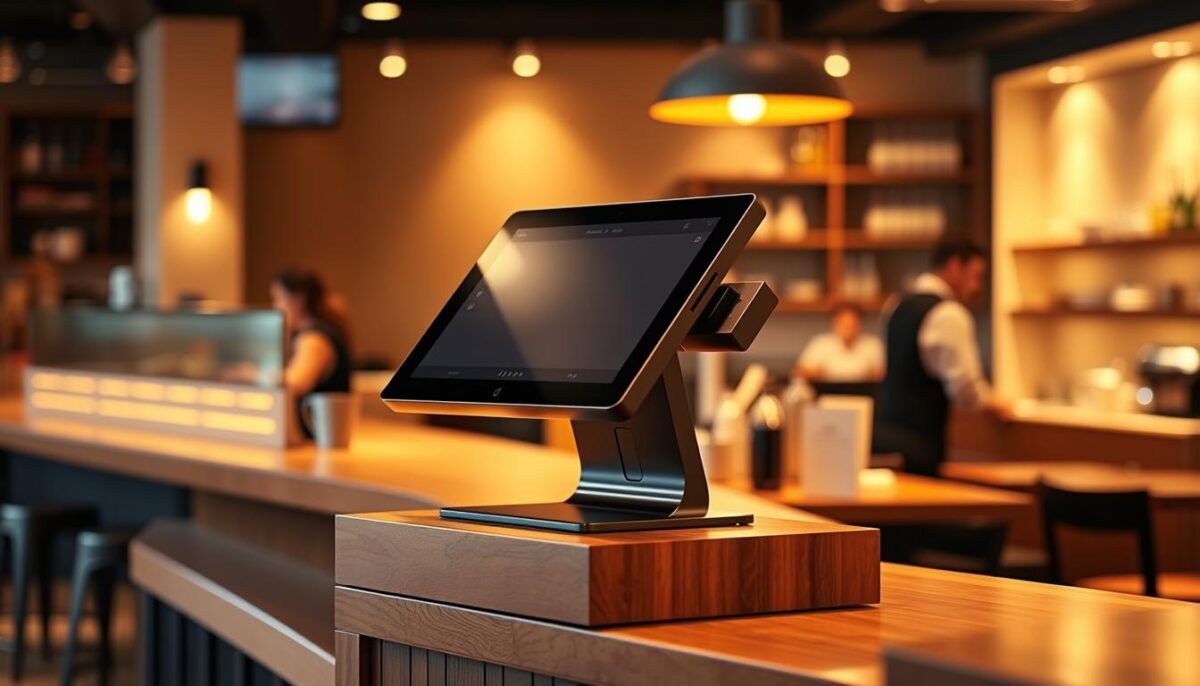
Questions to Ask Before Making a Decision
Before making a decision, ask potential POS providers specific questions about contract terms, hidden fees, hardware requirements, integration capabilities with your existing tools, and the availability and quality of customer support.
- Take advantage of free demos and trial periods whenever possible, and try to speak with current users of the system—particularly those running similar restaurant concepts—to get honest feedback about real-world performance.
- Consider the system’s scalability and whether it can grow with your business—a POS that works perfectly for a single location might become problematic when expanded to multiple sites.
- Don’t underestimate the importance of reliable customer support—a system with slightly fewer features but excellent 24/7 support might ultimately be more valuable than a feature-rich option with poor service availability.
By carefully assessing your restaurant’s specific needs and asking the right questions, you can find a POS system that enhances your operations, improves customer satisfaction, and drives business growth.
Understanding the Total Cost of Ownership
Understanding the total cost of a restaurant POS system is vital for making an informed decision. When evaluating the cost, it’s essential to consider multiple factors beyond the initial investment or the advertised monthly software fee.
The total cost of ownership for a restaurant POS system includes hardware costs, software fees, and payment processing fees. Each of these components contributes to the overall expense and can vary significantly between different POS systems.
Hardware Costs
Hardware costs can vary dramatically between systems. For a countertop register setup that includes a POS terminal, card reader, receipt printer, and cash drawer, expect to pay around $800 to $1,700 upfront. Additional hardware accessories like kitchen display systems or handheld terminals for tableside ordering can further increase the initial investment.
As noted by industry experts, “The initial hardware cost is just the beginning. Restaurants should also consider taxes, delivery fees, and potential setup and training fees, which can add to the overall cost.”
Software Fees
Software fees for restaurant POS systems can range from free to around $60 or $70 per month for basic plans. However, most companies charge extra fees per additional terminal, and features like advanced inventory management, vendor management, or online ordering can further increase the monthly cost.
- Basic plans: $60-$70 per month
- Additional terminal fees: Varying costs
- Advanced feature fees: Extra charges for services like online ordering and inventory management
Payment Processing Fees
Payment processing fees have the most significant long-term impact on the total cost of a POS system. Rates typically range from 1.99% to 3.5% plus a per-transaction fee. For high-volume restaurants, the difference in processing fees can amount to thousands of dollars annually.
To minimize costs, it’s crucial to avoid monthly PCI compliance fees and high chargeback fees (those over $25 per dispute). Flat-rate processing services, like those offered by Square and Toast, can be convenient but may not be the most cost-efficient option for all restaurants.
When evaluating different POS systems, creating a 3-year projection for each system can help you understand the total cost of ownership. This projection should include all hardware, software, processing fees, and additional charges based on your anticipated transaction volume and growth.
By carefully considering these factors and doing a thorough cost comparison, you can make an informed decision that meets your restaurant’s needs and budget.
Implementation and Training Considerations
When it comes to implementing a new POS system, restaurants need to consider several key factors to ensure a smooth transition. A well-planned implementation process is crucial for maximizing the benefits of your POS system.
Setup and Integration Timeline
Successful implementation of a new restaurant POS system requires careful planning, with typical timelines ranging from 2-6 weeks depending on the complexity of your menu, the number of locations, and the extent of integrations with other business systems. I recommend scheduling your POS implementation during a traditionally slower period for your restaurant, as the transition will inevitably cause some disruption to normal operations regardless of how well you prepare.
To ensure a seamless integration, create a detailed implementation plan with your POS provider that includes key milestones like menu building, hardware installation, integration testing, staff training, and a soft launch period before fully transitioning to the new system. For multi-location restaurants, consider a phased rollout approach—starting with one location as a pilot site to identify and resolve issues before implementing across all sites.
Staff Training Best Practices
Staff training is absolutely critical to successful implementation, with most restaurants underestimating the time required—I recommend allocating at least 2-3 training sessions per staff group (servers, bartenders, managers) before going live. Designate “super users” within your team who receive advanced training and can serve as in-house experts to support other staff members during and after the transition period.
Develop role-specific training materials that focus on the tasks each position needs to master rather than trying to train everyone on all system features—servers need different skills than managers or kitchen staff. After implementation, schedule regular check-ins with your POS provider for the first 3-6 months to address any issues, optimize system settings, and ensure you’re taking full advantage of all available features.
Don’t underestimate the importance of ongoing training as you hire new staff or as the POS system receives updates with new features and capabilities. By prioritizing staff training and ongoing support, you can maximize the benefits of your POS system and improve overall restaurant operations.
Conclusion: Making Your Final Decision
As we conclude our comprehensive comparison of restaurant POS systems for 2025, it’s clear that the best solution depends on your restaurant’s unique needs. The diverse range of options available means that there’s no one-size-fits-all answer.
Choosing the Right POS System involves considering several key factors, including your business model, service style, growth plans, and budget constraints. For instance, small and growing establishments may find Square’s free plan and affordable hardware options to be an ideal starting point.
- Restaurants focusing on both dine-in and online business may prefer Toast POS for its seamless integration capabilities, despite higher processing fees for online orders.
- Quick-service restaurants with high transaction volumes can benefit from Clover’s robust hardware and mobile POS features.
- Established multi-location operations may find Lightspeed’s advanced management tools and reporting features to be a worthwhile investment.
- For unique concepts requiring customization, SpotOn’s extensive add-on features offer the flexibility needed.
Beyond features and pricing, it’s essential to consider the human element of your decision, including customer service quality, training resources, and the provider’s commitment to updates and improvements. Your POS system is a long-term business partner, not just a tool.
When making your final decision, plan for a thorough implementation process and comprehensive staff training to maximize your investment. By doing so, you’ll be able to transform your restaurant operations and achieve your business goals.
In conclusion, the right restaurant POS system in 2025 is one that aligns with your business vision, enhances operational efficiency, and supports your growth plans. Take the time to assess your needs, evaluate the options, and choose a system that will be a valuable partner in your restaurant’s success.
FAQ
What is the average cost of a restaurant POS system?
The cost can vary widely, but on average, you can expect to pay between to 0 per month, depending on the features and the number of terminals.
Do I need to purchase hardware for a POS system?
Some POS providers, like Square, offer hardware for purchase or rent, while others may require you to buy it outright; it’s essential to factor this into your overall cost.
Can a POS system help with online ordering and delivery?
Yes, many modern POS systems, such as Toast POS and TouchBistro, integrate with online ordering and delivery platforms to streamline your operations.
How do POS systems handle inventory management?
Advanced POS systems like Lightspeed Restaurant offer inventory management tools that allow you to track inventory levels, set alerts for low stock, and optimize your ordering process.
Are POS systems secure for processing transactions?
Reputable POS providers prioritize security, using EMV compliance, encryption, and tokenization to protect your customers’ payment information.
Can I use a POS system to manage customer loyalty programs?
Many POS systems, such as Clover Restaurant, offer built-in loyalty programs or integrate with third-party apps to help you reward repeat customers.
How long does it take to implement a new POS system?
Implementation times vary, but most providers can have you up and running within a few days to a few weeks, depending on the complexity of your setup and the level of support.
What kind of customer support can I expect from a POS provider?
Top POS providers offer 24/7 support through multiple channels, including phone, email, and online chat, to ensure you get help when you need it.
Can a POS system integrate with my existing accounting software?
Many POS systems offer integrations with popular accounting software, making it easier to manage your financials and reduce errors.
